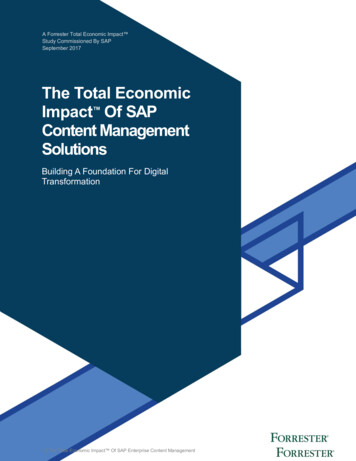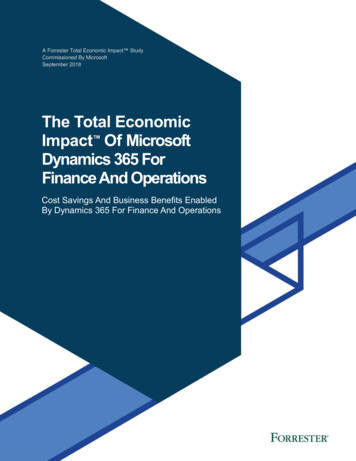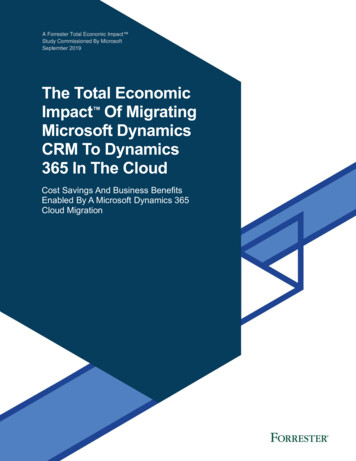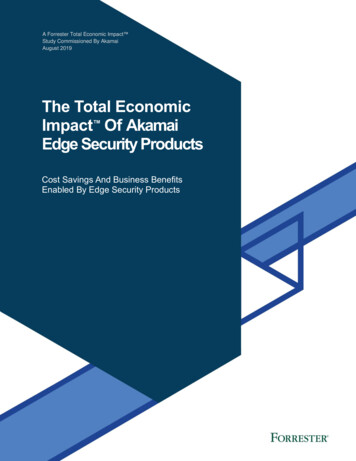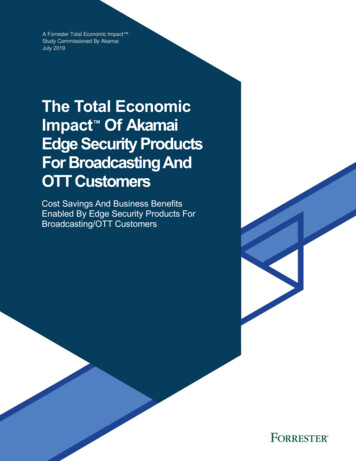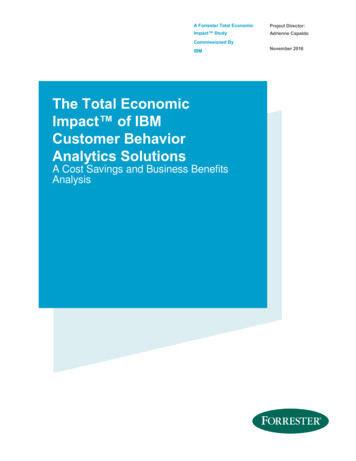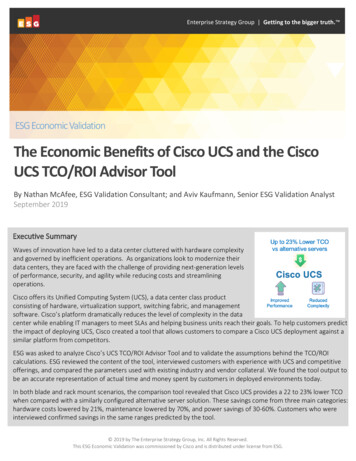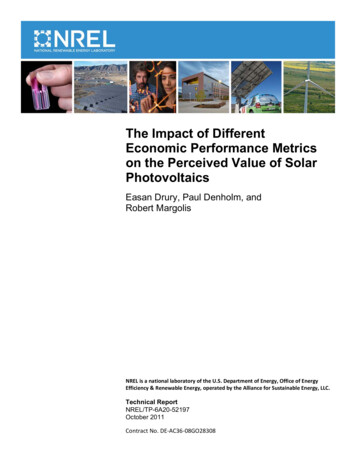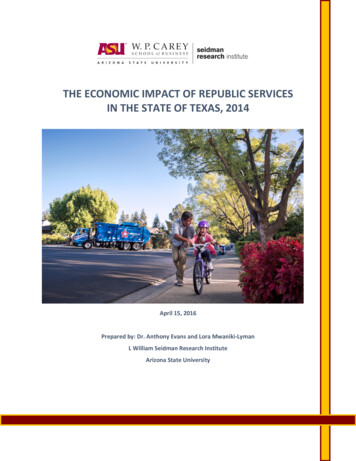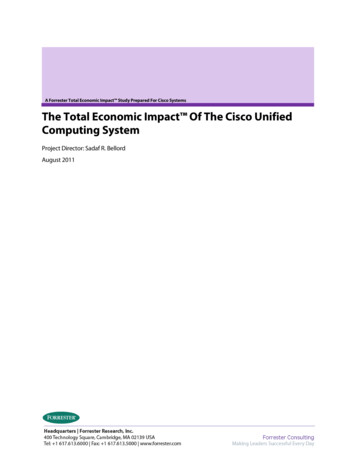
Transcription
A Forrester Total Economic Impact Study Prepared For Cisco SystemsThe Total Economic Impact Of The Cisco UnifiedComputing SystemProject Director: Sadaf R. BellordAugust 2011
Forrester ConsultingThe Total Economic Impact Of The Cisco Unified Computing SystemTABLE OF CONTENTSExecutive Summary . 2Cisco UCS Reduces IT Administrative and Hardware Costs . 2Factors Affecting Benefits And Costs . 5Disclosures . 5TEI Framework And Methodology. 7Analysis . 8Interview Highlights . 8Costs. 10Benefits . 16Flexibility. 23Risk. 23Financial Summary. 24Cisco Unified Computing System: Overview . 25Appendix A: Composite Organization Description . 27Appendix B: Total Economic Impact Overview . 27Appendix C: Glossary . 28Appendix D: Endnotes. 30 2011, Forrester Research, Inc. All rights reserved. Unauthorized reproduction is strictly prohibited. Information is based on best available resources.Opinions reflect judgment at the time and are subject to change. Forrester , Technographics , Forrester Wave, RoleView, TechRadar, and TotalEconomic Impact are trademarks of Forrester Research, Inc. All other trademarks are the property of their respective companies. For additionalinformation, go to www.forrester.com.About Forrester ConsultingForrester Consulting provides independent and objective research-based consulting to help leaders succeed in their organizations. Ranging inscope from a short strategy session to custom projects, Forrester’s Consulting services connect you directly with research analysts who applyexpert insight to your specific business challenges. For more information, visit www.forrester.com/consulting.Page 1
Forrester ConsultingThe Total Economic Impact Of The Cisco Unified Computing SystemExecutive SummaryIn March 2011, Cisco Systems commissioned Forrester Consulting to examine the total economic impact and potentialreturn on investment (ROI) enterprises may realize by deploying Cisco Unified Computing System (UCS). Thepurpose of this study is to provide readers with a framework to evaluate the potential financial impact of Cisco UCS ontheir organizations.Cisco UCS Reduces IT Administrative and Hardware CostsOur interviews with five existing customers and subsequent financial analysis found that a composite organizationbased on the organizations we interviewed experienced the risk-adjusted ROI, costs, and benefits shown in Table 1. SeeAppendix A for a description of the composite organization. All values have been rounded.Forrester interviewed five existing Cisco UCS customers, completed financial analysis on these customers and modeleda representative composite organization based these interviews. The composite organization experienced the riskadjusted ROI, costs, and benefits shown in Table 1. See Appendix A for a description of the composite organization. Allvalues have been rounded.Table 1Composite Organization Three-Year Risk-Adjusted ROI1ROIPaybackperiodTotal benefits(PV)Total costs(PV)Net presentvalue (NPV)177%4 months 1,345,029( 485,385) 859,644Source: Forrester Research, Inc. Benefits. The organizations interviewed experienced the following benefits (see figure 1):Page 2oReduction in ongoing administrative effort. (Total benefit equates a 307,076 reduction on a totaladministrative cost of 614,000).This represents the time and effort reduced when managing the datacenter. Organizations can maximize their IT resources and eliminate mundane tasks.oNetwork port and switch cost reduction. (Total benefit equates to 703,462).This represents thereduction of 400 IP and 400 FC ports required to connect into the data center using UCS. UCSsimplified structure reduces time and effort as well as capital expenditure. This category primarilymeasures the capital expenditure reduction.oRefresh cost avoidance. (Total benefit equates to 185,663). This represents the hardware refreshes costthat was avoided.
Forrester ConsultingThe Total Economic Impact Of The Cisco Unified Computing SystemoPower and cooling cost savings. (Total benefit equates to 38,994, a 30% savings on a total cost of 129,980).This represents the difference in power and cooling costs between the new UCS environmentand the prior traditional server and networking architect.oThe reduction in electrical circuits deployed. (Total benefit equates 42,764). This represents thereduction in power outlets necessary for the new UCS hardware versus the outlets required to supportthe original environment and growth.oData center space cost savings. (Total benefit equates 38,994, presenting an annual savings of 16,000).This represents the reduction in data center space after implementing UCS.oEnd user productivity savings. (Total benefit equates 28,076). This represents an improvement in enduser productivity when organizations reduced the number of planned and unplanned downtimes. Costs. The organizations we interviewed experienced the following costs (see figure 2):Page 3oUCS hardware, license, and annual maintenance fees. This cost represents the investment in UCShardware license fee and the annual maintenance cost.oUCS port and switch costs. This cost represents the investment in switches and ports required to runUCS.oImplementation costs. This category represents the IT staff time allocated to discovery, testing, anddeployment of Cisco UCS.oTraining costs. This cost represents the fee paid to attend third-party training course for UCS.oTraining opportunity costs. This section represents the IT staff time allocated to attend UCS trainingcourse.oProfessional services fees. This cost represents the investment for a member of the Cisco professionalservices team to be on-site during initial implementation of UCS.
Forrester ConsultingThe Total Economic Impact Of The Cisco Unified Computing SystemFigure 1Composite Organization Three-Year Total Benefits Breakdown Risk-Adjusted AnalysisEnd‐userproductivitysavings 28,076Electric circuitcost avoidance 42,764Power andcooling savings 38,994Refresh costavoidance 185,663Reduction inon‐goingadministrativeeffort 307,076Network portswitch costavoidance 703,462Data centerspace costsavings 38,994Source: Forrester Research, Inc.Figure 2Composite Organization Three-Year Total Costs Breakdown Risk-Adjusted AnalysisTraining FeesTraining ( 10,100)opportunitycosts( 3,248),Professionalservices fees( 10,100)UCS port andswitch costs( 23,302)ImplementationCosts( 50,753)UCS hardware,license andmaintenancefees( 387,882)Source: Forrester Research, Inc.Page 4
Forrester ConsultingThe Total Economic Impact Of The Cisco Unified Computing SystemFigure 3Composite Organization Three-Year Risk-Adjusted Analysis 1,200,000 1,000,000 800,000 600,000Total costs 400,000Total benefitsPayback 200,000 0InitialYear 1Year 2Year 3( 200,000)( 400,000)Source: Forrester Research, Inc.Factors Affecting Benefits And CostsTable 1 illustrates the risk-adjusted financial results that were achieved by the composite organization. The riskadjusted values take into account any potential uncertainty or variance that exists in estimating the costs and benefits,which produces more conservative estimates. The following factors may affect the financial results that an organizationmay experience: Improvement in IT administrative effort when installing and managing hardware. The simplified environmentreduced the number of mundane and repeatable tasks that could cause unnecessary user errors. Those using theadvanced technology features of UCS to more fully streamline their internal processes will experiencecommensurately larger gains. Conversely, those that choose to rigidly adhere to former processes may experiencelower benefits. The ability to avoid the investment in additional switches and ports necessary to connect into the data center. Improvement in end user productivity that may result from reduction in planned and unplanned downtime asthe IT organization uses hardware and solutions that simplified its environment. Business benefits fromavoidance of unplanned downtime are typically difficult to accurately model.DisclosuresThe reader should be aware of the following:Page 5
Forrester ConsultingThe Total Economic Impact Of The Cisco Unified Computing System The study is commissioned by Cisco and delivered by the Forrester Consulting group. Forrester makes no assumptions as to the potential ROI that other organizations will receive. Forrester stronglyadvises that readers should use their own estimates within the framework provided in the report to determine theappropriateness of an investment in Cisco UCS. Cisco reviewed and provided feedback to Forrester, but Forrester maintains editorial control over the study andits findings and does not accept changes to the study that contradict Forrester’s findings or obscure the meaningof the study. The customer names for the interviews were provided by Cisco. Forrester conducted independent interviewswith no Cisco presence and Cisco did not edit any of the customer comments, input or results.Page 6
Forrester ConsultingThe Total Economic Impact Of The Cisco Unified Computing SystemTEI Framework And MethodologyIntroductionFrom the information provided in the interviews, Forrester has constructed a Total Economic Impact (TEI)framework for those organizations considering implementing Cisco UCS. The objective of the framework is to identifythe cost, benefit, flexibility, and risk factors that affect the investment decision.Approach and MethodologyForrester took a multistep approach to evaluate the impact that Cisco UCS can have on an organization (see Figure 2).Specifically, we: Interviewed Cisco marketing, sales, consulting personnel and Forrester analysts to gather data relative to Ciscoand the marketplace for UCS. Interviewed five organizations currently using Cisco UCS to obtain data with respect to costs, benefits, and risks. Designed a composite organization based on characteristics of the interviewed organizations (see Appendix A). Constructed a financial model representative of the interviews using the TEI methodology. The financial model ispopulated with the cost and benefit data obtained from the interviews as applied to the composite organization.Figure 2TEI ApproachPerform duediligenceConductcustomerinterviewsDesign compositeorganizationConstruct financialmodel using TEIframeworkWrite casestudySource: Forrester Research, Inc.Forrester employed four fundamental elements of TEI in modeling Cisco UCS’s service:1.Costs.2.Benefits to the entire organization.3.Flexibility.4.Risk.Given the increasing sophistication that enterprises have regarding ROI analyses related to IT investments, Forrester’sTEI methodology serves the purpose of providing a complete picture of the total economic impact of purchasedecisions. Please see Appendix B for additional information on the TEI methodology.Page 7
Forrester ConsultingThe Total Economic Impact Of The Cisco Unified Computing SystemAnalysisInterview HighlightsA total of five interviews were conducted for this study, involving representatives from the following companies (Ciscocustomers based in the US):1.A provider of critical communication and compliance solutions. The firm has about 150 employees and3,500 customers. The firm’s innovation a
framework for those organizations considering implementing Cisco UCS. The objective of the framework is to identify the cost, benefit, flexibility, and risk factors that affect the investment decision. Approach and Methodology Forrester took a multistep approach to evaluate the impact that Cisco UCS can have on an organization (see Figure 2). Specifically, we: Interviewed Cisco marketing .
